Iceland, the land of fire and ice, boasts a raw, otherworldly beauty that captivates travelers year-round. Yet, there’s a local saying that perfectly encapsulates the spirit of adventure here: Þetta reddast. Pronounced “thetta rettast,” it loosely translates to “it’ll all work out.” This isn’t just a saying; it’s a national mantra, a testament to the Icelandic resilience and adaptability when facing the unpredictable nature of their stunning island. As my Reykjavik-based friend Pétur Magnusson explains, “Þetta reddast is deeply ingrained in our identity. It’s what we say when we embrace the unexpected, when we roll with the punches, no matter what challenges come our way.” It’s about accepting the elements beyond your control and cleverly adjusting what you can.
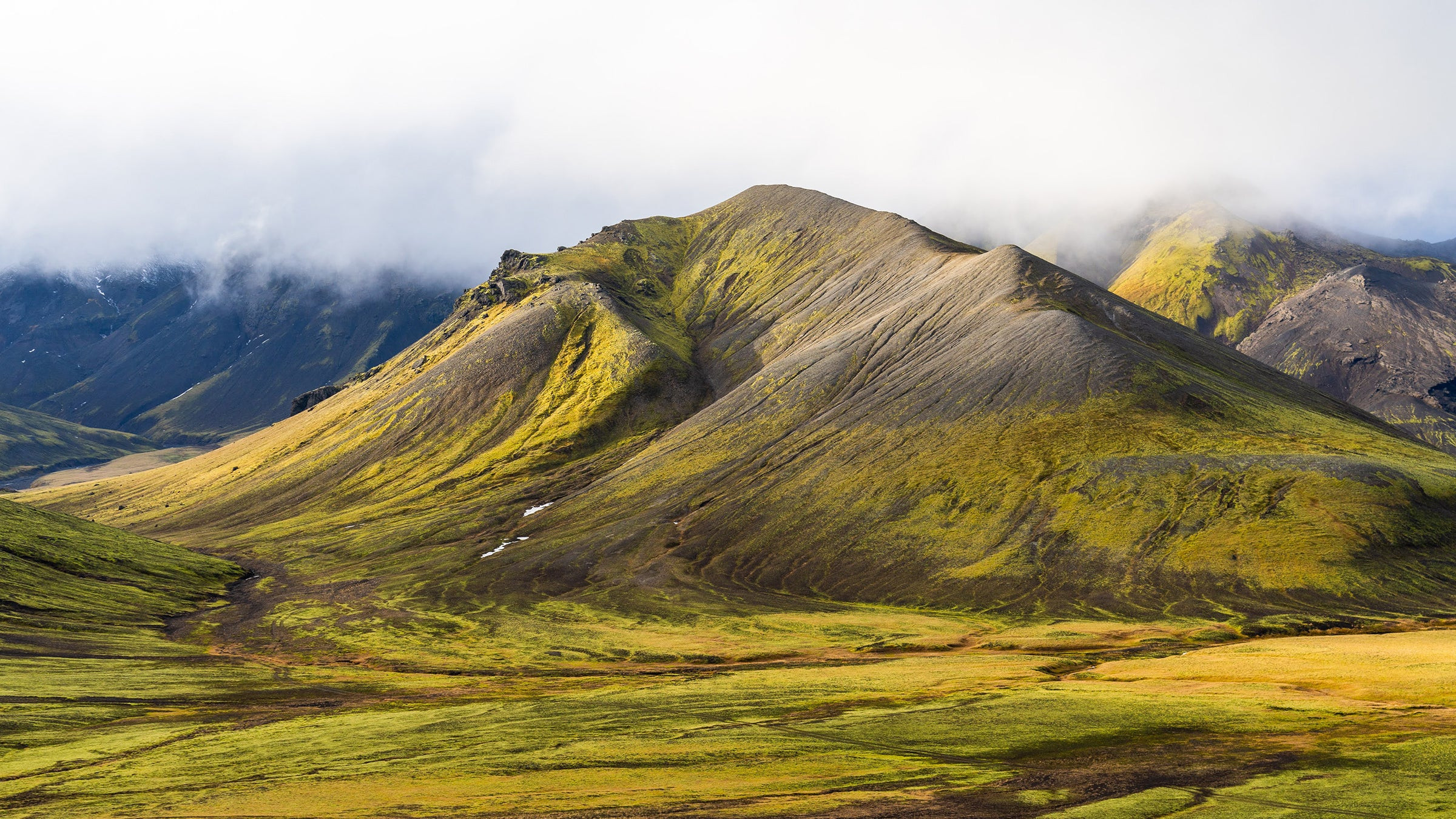 The stunning Icelandic highlands in fall
The stunning Icelandic highlands in fall
The Icelandic Highlands in Autumn: A breathtaking landscape in Iceland, showcasing the rugged beauty of the highlands during fall.
This philosophy is invaluable for anyone planning Iceland Travel, especially first-timers venturing into this rugged and remote destination. “Unpredictable” barely scratches the surface when describing Iceland’s weather, and unexpected events, like volcanic activity, can always add a twist to your plans. Recent eruptions near Grindavik in southern Iceland have led to travel advisories for that specific area. However, the vast majority of Iceland remains open and ready to welcome intrepid explorers. If you’re willing to embrace the Þetta reddast attitude, you’re in for an unforgettable experience, particularly if you consider Iceland travel during the shoulder season.
Last October, I finally had the chance to explore Iceland myself. Thanks to my friend Pétur, who grew up in Iceland before we became friends in California, I had the unique opportunity to see this incredible country through the eyes of a local. Pétur’s return to Iceland during the pandemic presented the perfect chance for a two-week adventure. We traversed the island, constantly adapting to the ever-changing weather, capturing countless photos, and thoroughly enjoying every moment. Here’s what I learned about making the most of Iceland travel.
Why Off-Season Iceland Travel is the Best Kept Secret
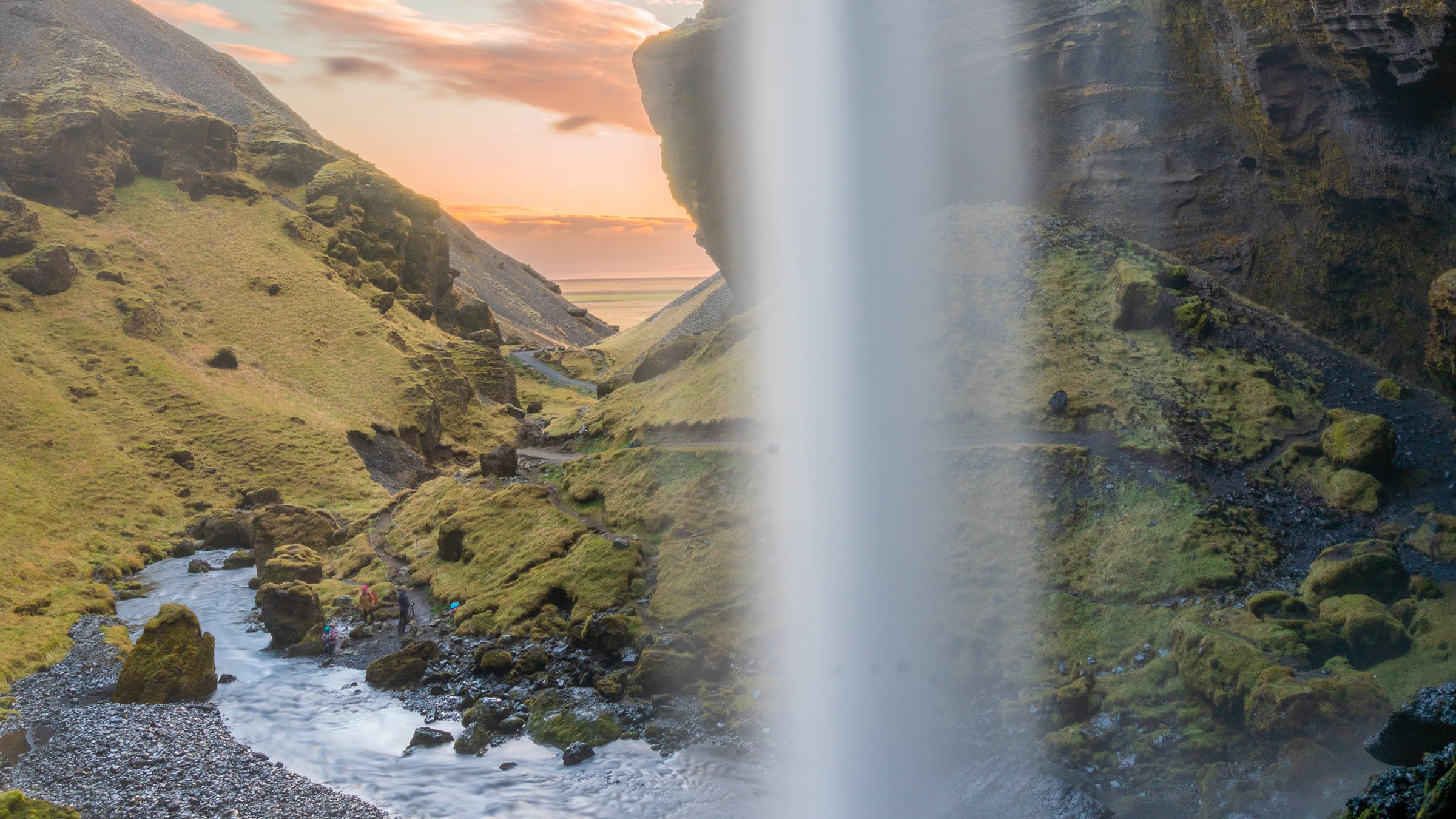 Golden hour in the cave behind Seljalandsfoss waterfall
Golden hour in the cave behind Seljalandsfoss waterfall
Golden Hour at Seljalandsfoss Waterfall Cave: The magical light of golden hour illuminating the cave behind Seljalandsfoss waterfall in Iceland.
Opting for Iceland travel during the shoulder season – encompassing autumn and spring – offers several compelling advantages that enhance your experience and make your trip more rewarding:
Budget-Friendly Iceland Travel
While flights to Iceland are often reasonably priced (especially with Icelandair’s numerous direct flights from North America), on-the-ground expenses can quickly add up. Accommodation, rental cars, tours, and many other costs are significantly lower outside the peak summer months. Choosing the shoulder season for your Iceland travel is a smart way to make your budget go further, allowing you to experience more for less.
Fewer Crowds, More Iceland to Yourself
One of the most significant perks of off-season Iceland travel is the noticeable decrease in tourist crowds. This translates to less congested trails, more intimate encounters with Iceland’s natural wonders, better photo opportunities without throngs of people, and crucially, greater flexibility with last-minute bookings. This flexibility is essential for adapting to Iceland’s unpredictable conditions and maximizing your trip. Imagine having iconic spots almost to yourself – a far cry from the summer rush.
Witness the Majestic Aurora Borealis
The Northern Lights, or Aurora Borealis, are primarily visible during the off-season. Iceland’s northerly location means that during the summer’s high season, the sky simply doesn’t get dark enough for the aurora to appear. Iceland is renowned as one of the best places on Earth to witness this celestial spectacle. So, if seeing the Northern Lights is on your bucket list, then pack your warmest layers and plan your Iceland travel for the shoulder season. (More tips on prime Northern Lights viewing spots are coming up.)
Essential Tips for Shoulder-Season Iceland Travel
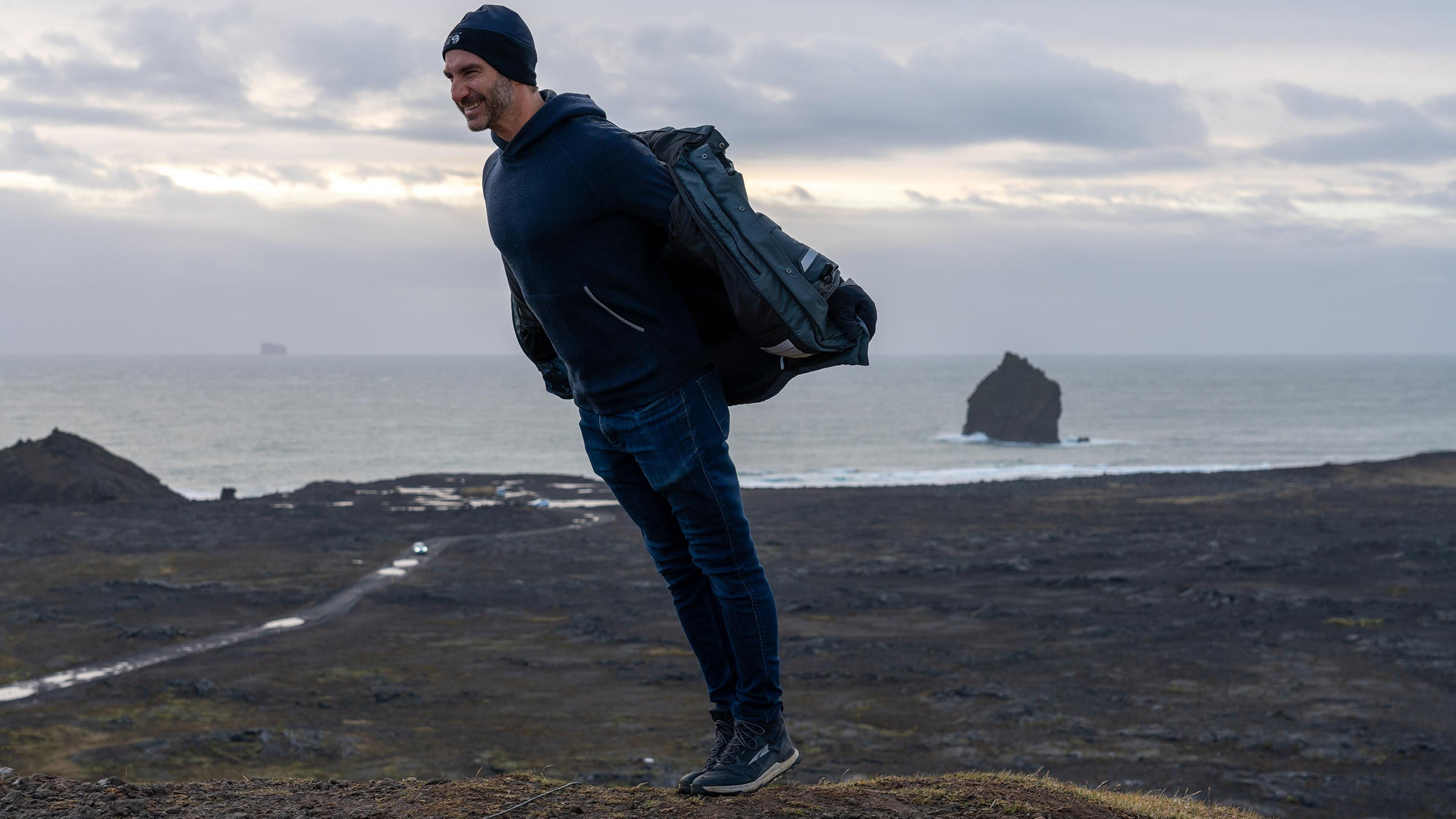 The wind gusts were actually strong enough to hold the author up like this.
The wind gusts were actually strong enough to hold the author up like this.
Powerful Icelandic Winds: Demonstrating the strength of Iceland’s winds, capable of supporting a person’s weight.
Of course, Iceland travel in the shoulder season does come with its own set of considerations. The weather, first and foremost, demands respect. Situated south of the Arctic Circle in the North Atlantic, Iceland is prone to rain, snow, and its infamous wind, especially during the colder months. Daylight hours are also shorter, so maximizing your time each day becomes crucial.
Iceland Packing Essentials: Gear Up for Adventure
Layering is absolutely key when packing for Iceland travel, and bringing ample layers is highly recommended. My daily attire during my trip looked something like this:
- Thermal base layers (top and bottom)
- Heavy wool hiking socks
- Altra Lone Peak hiking boots (reliable and comfortable for varied terrain)
- Warm Smartwool hoodie
- REI XeroDry GTX Gore-Tex rain pants (excellent for wind and rain protection)
- Mountain Hardware Boundary Ridge gloves (essential for keeping hands warm and dry)
- Super-warm, wind and rain-proof Helly Hansen Tromsoe Jacket
- Wind-proof Mountain Hardware Dome Perignon Pro hat
This gear combination kept me comfortably warm and dry, even when facing sideways rain and strong winds.
Tech Tip: Don’t forget a European power adapter, as Iceland uses European plugs. Bringing one or two, along with a power strip, will ensure you can charge all your devices efficiently.
Now, let’s get to the exciting part – exploring Iceland!
Getting Around Iceland: Transportation for Every Explorer
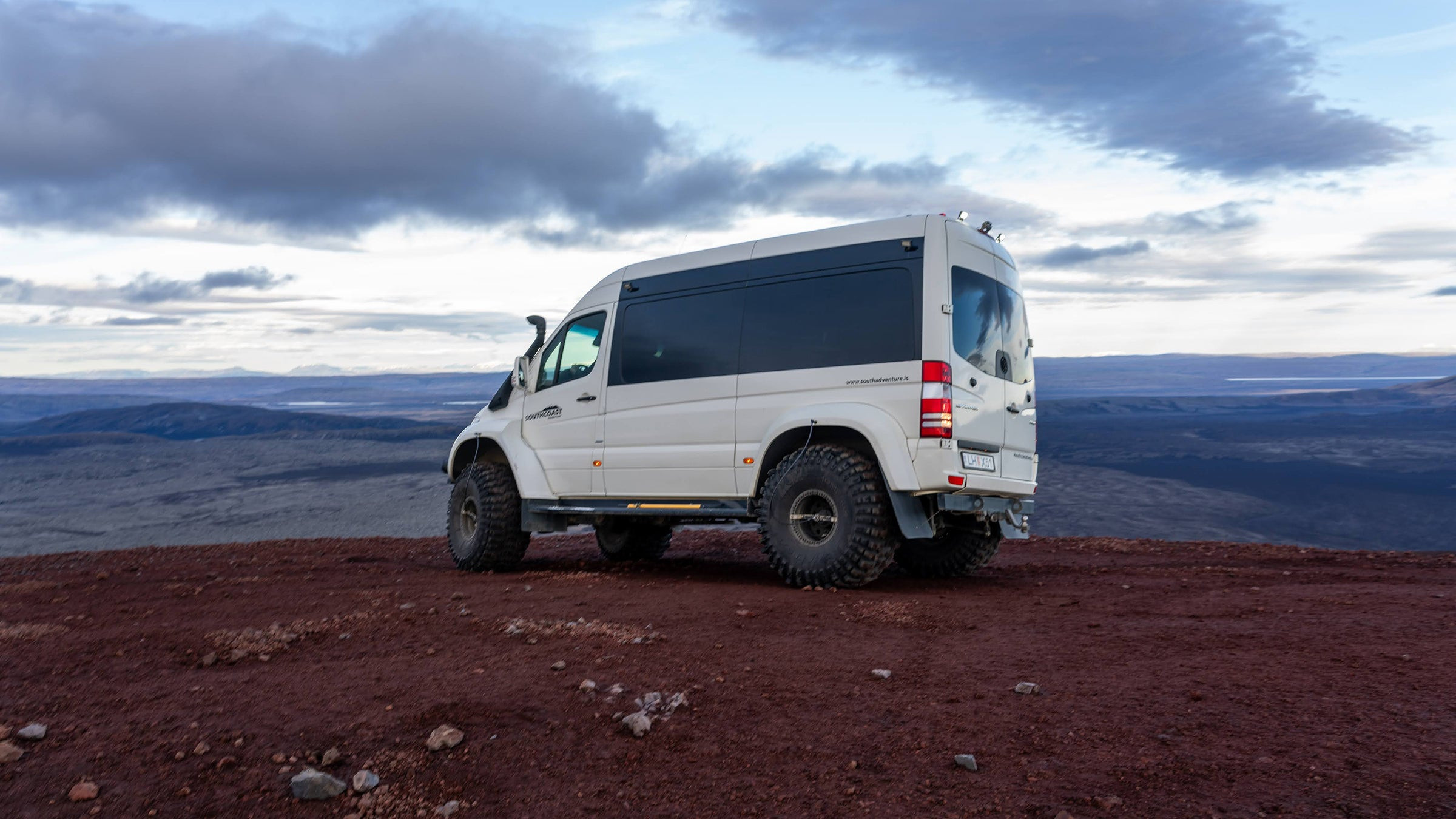 One of Iceland’s so-called “Super-Jeeps” on a volcanic mesa deep in the interior
One of Iceland’s so-called “Super-Jeeps” on a volcanic mesa deep in the interior
Icelandic Super Jeep Adventure: A robust “Super-Jeep” navigating Iceland’s volcanic interior, perfect for off-road exploration.
Iceland is best explored with your own vehicle. While buses are available in certain areas, for true adventure and access to remote locations, independent transportation is a must. Tour groups are an option, but they limit your itinerary and often place you in crowded tourist hotspots.
Renting the Right Vehicle for Iceland Travel
Choosing the right vehicle is paramount for successful Iceland travel, especially outside of summer. Winter conditions bring icy and snowy roads, making vehicle selection critical. Even if you plan to stick to hotels and avoid camping, I strongly advise renting a vehicle with all-wheel drive (AWD) or four-wheel drive (4WD), equipped with robust tires and ample ground clearance. This will significantly enhance your safety and allow you to venture off the main roads, discovering more of Iceland with fewer crowds. MyCar Iceland is a great place to start your search, offering a range of 4WD Toyotas starting from around $84 per day.
Campervan or Rooftop Tent: Your Home on Wheels
For adventurous Iceland travel, consider a campervan or a 4×4 with a rooftop tent. These are popular choices among outdoor enthusiasts, providing both transportation and accommodation. Iceland boasts numerous scenic campsites across the island, and combining your lodging with your vehicle can be a significant cost-saver. Ensure your campervan has a reliable heater (diesel or propane) and, again, prioritize AWD or 4WD with appropriate tires and clearance. If opting for a rooftop tent, aim for Iceland travel during the milder shoulder months like September or May, as sleeping in a tent atop your car in harsh winter conditions can be extremely challenging.
Always read reviews of rental companies before booking to ensure they offer reliable SOS services – you don’t want to face vehicle issues in Iceland’s remote backcountry. Many campervans and rooftop tent setups include bedding, a basic kitchen, stove and fuel, and a cooler, providing excellent self-sufficiency. A portable WiFi router can also be a worthwhile addition for easier navigation and booking campsites on the go. Rent.is offers a variety of rooftop tent and campervan options to explore.
Stay Informed About Iceland Road Conditions
Regardless of your vehicle choice, the UMFERDIN website is an essential resource for real-time road conditions and closures. Checking this website regularly will save you valuable time and prevent unexpected detours.
Driving in Iceland requires caution. Be realistic about your driving skills and the capabilities of your rental vehicle. Ensure your tires have adequate tread for the conditions you expect to encounter. When in doubt, err on the side of caution and avoid driving into potentially dangerous situations.
Dining in Iceland: Navigating the Culinary Landscape
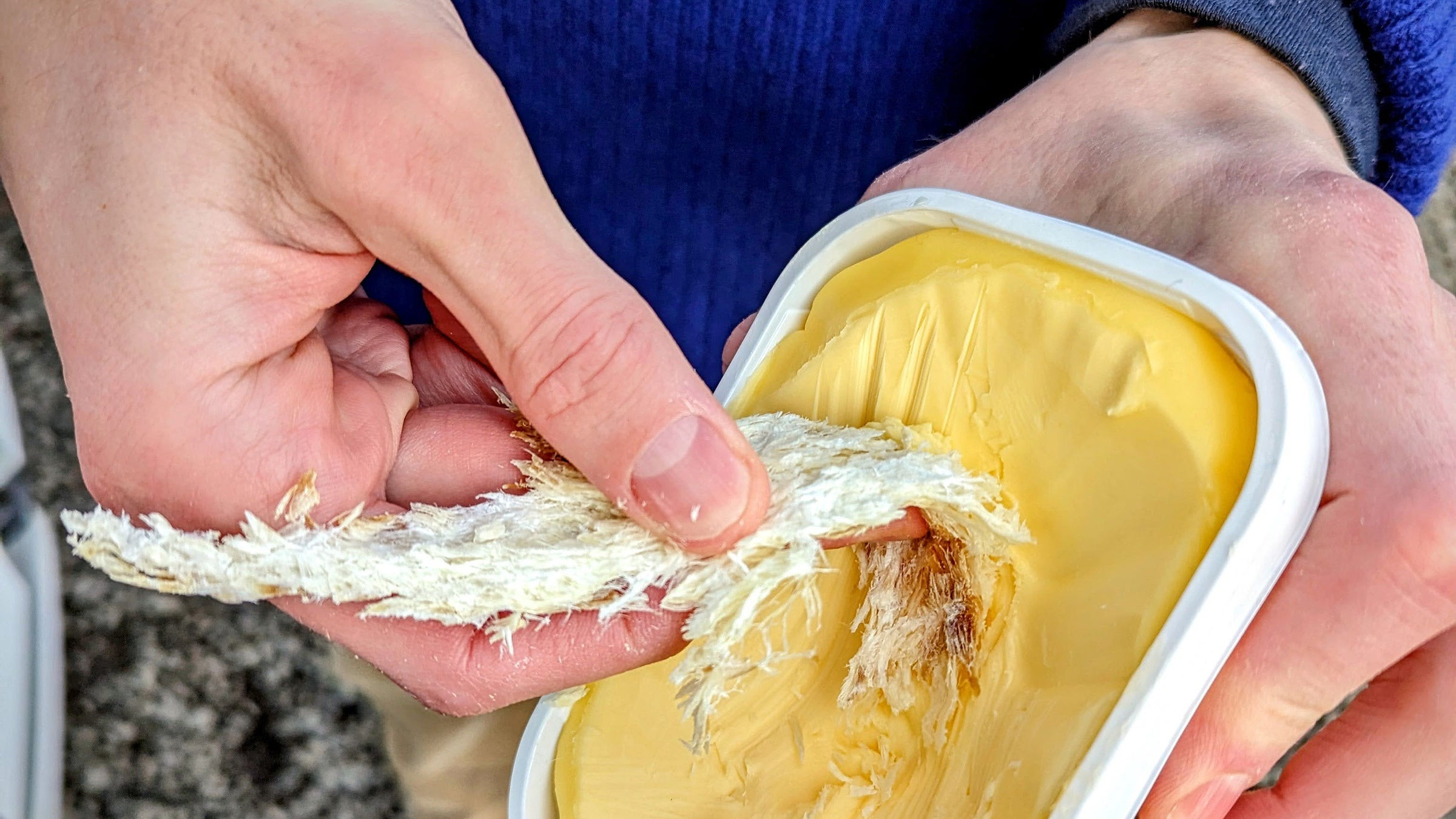 Cod jerky with Icelandic butter. Don’t knock it ‘till ya try it…
Cod jerky with Icelandic butter. Don’t knock it ‘till ya try it…
Icelandic Cod Jerky with Butter: A local delicacy of cod jerky paired with Icelandic butter, a must-try for adventurous eaters.
Let’s talk about food – a crucial aspect of any travel experience. In Iceland, dining can be universally expensive, largely because most food items are imported. While Iceland isn’t necessarily a foodie paradise, there are some culinary gems to discover. To manage costs, I recommend stocking up on groceries at supermarkets like Bonus or Krónan upon arrival in Reykjavik. Besides basic provisions like peanut butter and jelly, be sure to grab Icelandic yogurt, or skyr – it’s incredibly delicious and a local staple.
Don’t miss trying cod jerky, a local snack that my friend Pétur recommends eating with Icelandic butter. (Surprisingly tasty!). I also discovered exceptionally sweet and crunchy carrots in Iceland. For the truly adventurous, try salmiakbitar, the island’s famous salted black licorice – it’s definitely a divisive flavor!
Arrival and Exploration: Reykjavik and the Reykjanes Peninsula
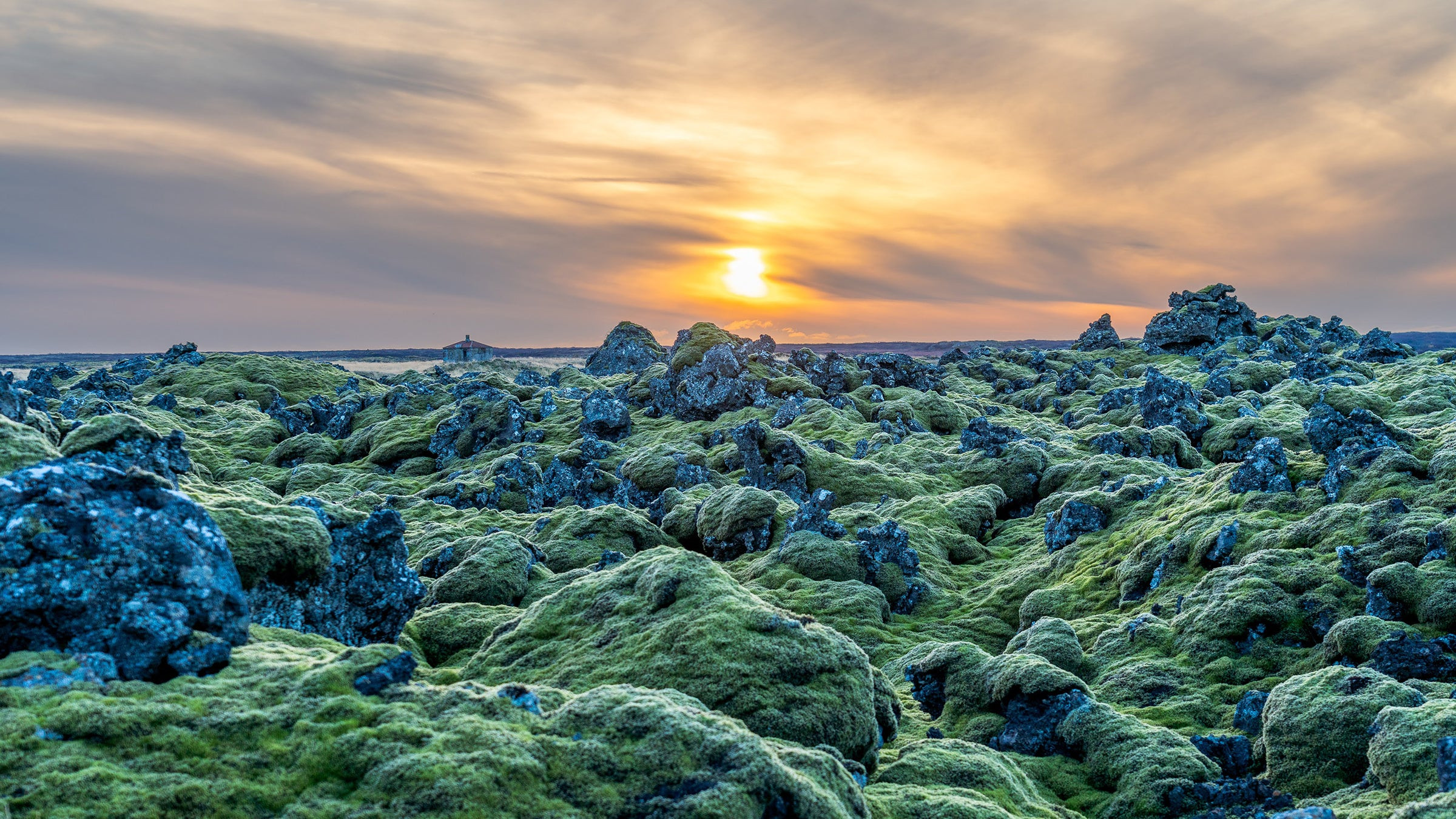 The whole Reykjanes peninsula is covered with stunning, moss-covered, volcanic boulder fields.
The whole Reykjanes peninsula is covered with stunning, moss-covered, volcanic boulder fields.
Moss-Covered Lava Fields of Reykjanes: Expansive lava fields blanketed in vibrant green moss, characteristic of the Reykjanes Peninsula in Iceland.
Your Iceland travel adventure begins at Keflavík International Airport. If you’re arriving from North America on a red-eye flight, you might feel quite jet-lagged. On your first day, consider taking it easy and exploring the Reykjanes Peninsula. Afterwards, head to Reykjavik to discover its museums and cultural attractions.
Reykjanes Peninsula Must-Sees
The 40-minute drive from the airport to Reykjavik is visually stunning, passing through vast lava fields that stretch to the horizon. You’ll also drive by the famous Blue Lagoon. However, be aware that many Icelanders view the Blue Lagoon as a tourist trap – beautiful, but overpriced (starting at $72) and often crowded. It may also be subject to closures due to volcanic activity in the region.
If you manage to sleep on the plane and are ready to explore immediately, the Reykjanes Peninsula offers several fantastic spots before you reach Reykjavik:
- Seltún Geothermal Area: Witness bubbling mud pools and steaming vents in this sulfurous, otherworldly landscape.
- Krísuvíkurberg Cliffs: Experience dramatic cliffs plunging into the powerful ocean – a truly breathtaking sight.
- Reykjanes Lighthouse & Valahnúkamöl: Explore the historic lighthouse and the beautiful, rocky Valahnúkamöl shoreline.
I had an amazing lobster soup at Café Bryggjan in Grindavík. Unfortunately, due to recent seismic activity and volcanic eruptions, this charming fishing village has been severely impacted. The town has physically sunk, and a large fissure now runs through it. The future of Grindavík is uncertain, highlighting the need to be adaptable during Iceland travel.
Reykjavik City Exploration
 One of many stunning sculptures at the Einar Jónsson Museum
One of many stunning sculptures at the Einar Jónsson Museum
Sculptures at Einar Jónsson Museum: Intricate and expressive sculptures displayed at the Einar Jónsson Museum in Reykjavik, Iceland.
Hot Dog Pilgrimage: Upon arriving in Reykjavik, your first mission should be to find a hot dog stand. Icelandic hot dogs are in a league of their own, featuring crispy fried onions, a variety of delicious sauces, soft buns, and flavorful wieners. They are a must-try and surprisingly affordable.
Historic Downtown Reykjavik: Explore the historic city center on foot. The Einar Jónsson Museum showcases impressive sculptures, and the waterfront area offers sights like the iconic Harpa Concert Hall.
Local Hot Springs Experience: For an authentic Icelandic experience, visit one of Reykjavik’s numerous public pools (like Laugardalslaug, entry around $10). These aren’t as luxurious as the Blue Lagoon, but they are a vital part of Icelandic culture. All heating in Iceland, including hot water, is geothermal, making these pools mineral-rich and incredibly relaxing. Public pools feature various hot tubs at different temperatures, saunas, cold plunges, and even waterslides.
Remember to follow the showering etiquette strictly (shower naked and thoroughly with soap before entering the pools). Icelanders consider these waters sacred, and disrespecting the pre-soak protocol is a major faux pas. Public pools are also social hubs, offering a chance to meet locals and perhaps get insider tips for your Iceland travel. While almost everyone in Iceland speaks English, learning a few basic Icelandic phrases will be appreciated.
Lamb Stew Dinner: For dinner, savor Kjötsúpa, a traditional Icelandic lamb stew. It’s hearty, flavorful, and perfect for a chilly evening. Afterwards, get a good night’s sleep before embarking on your Iceland road trip.
Shoulder-Season Iceland Itinerary: A Newbie’s Adventure
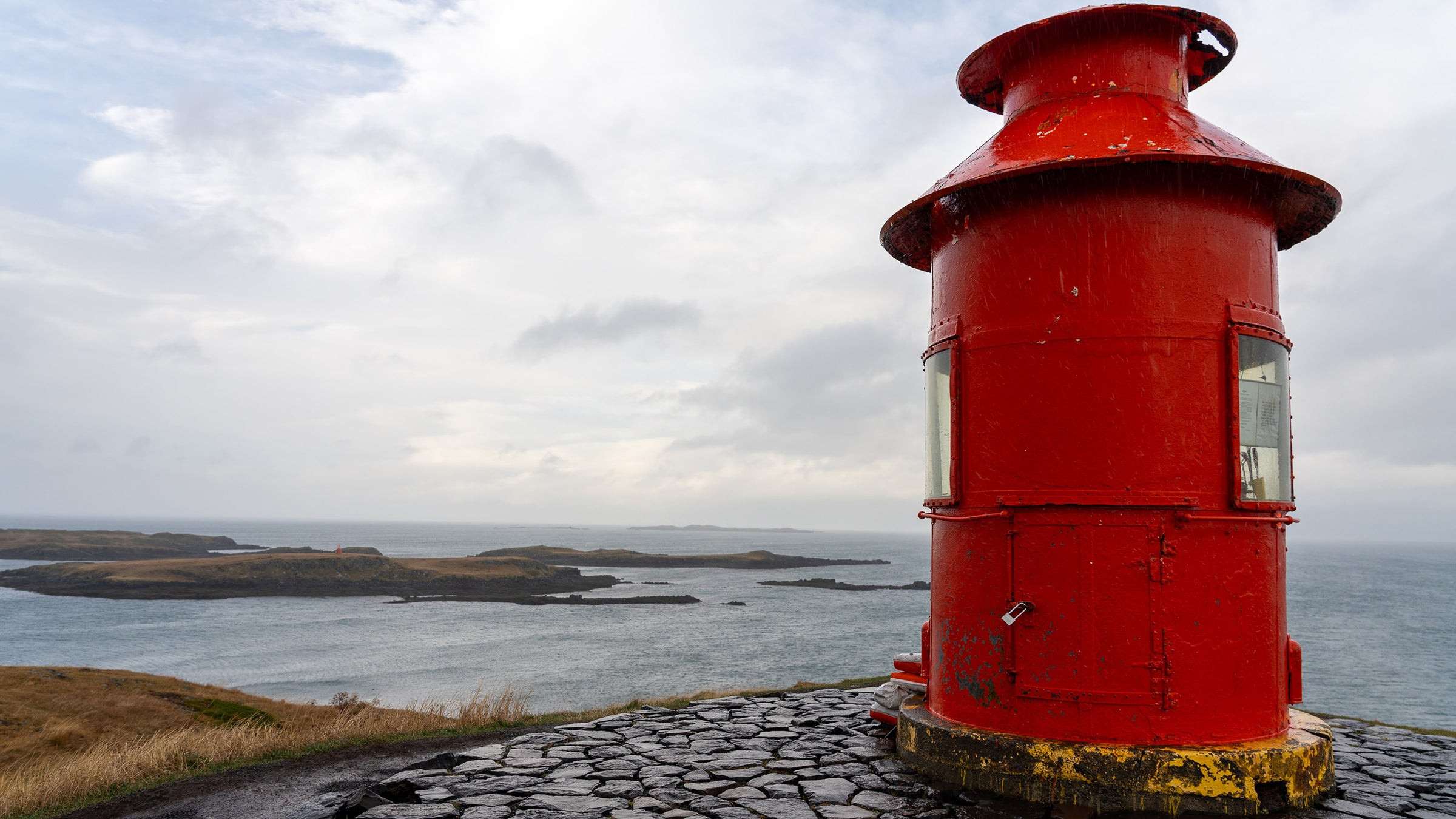 Súgandisey Island Lighthouse
Súgandisey Island Lighthouse
Súgandisey Island Lighthouse: The picturesque Súgandisey Island Lighthouse perched on a cliff in Iceland, offering stunning coastal views.
While Reykjavik is charming, the real allure of Iceland lies in its natural landscapes. My spontaneous trip evolved into a wonderful loop through western and southern Iceland. Consider these highlights as inspiration rather than a rigid itinerary, as flexibility is key for shoulder-season Iceland travel. Here are some of my trip highlights:
Day 1: Waterfalls and Geothermal Bliss
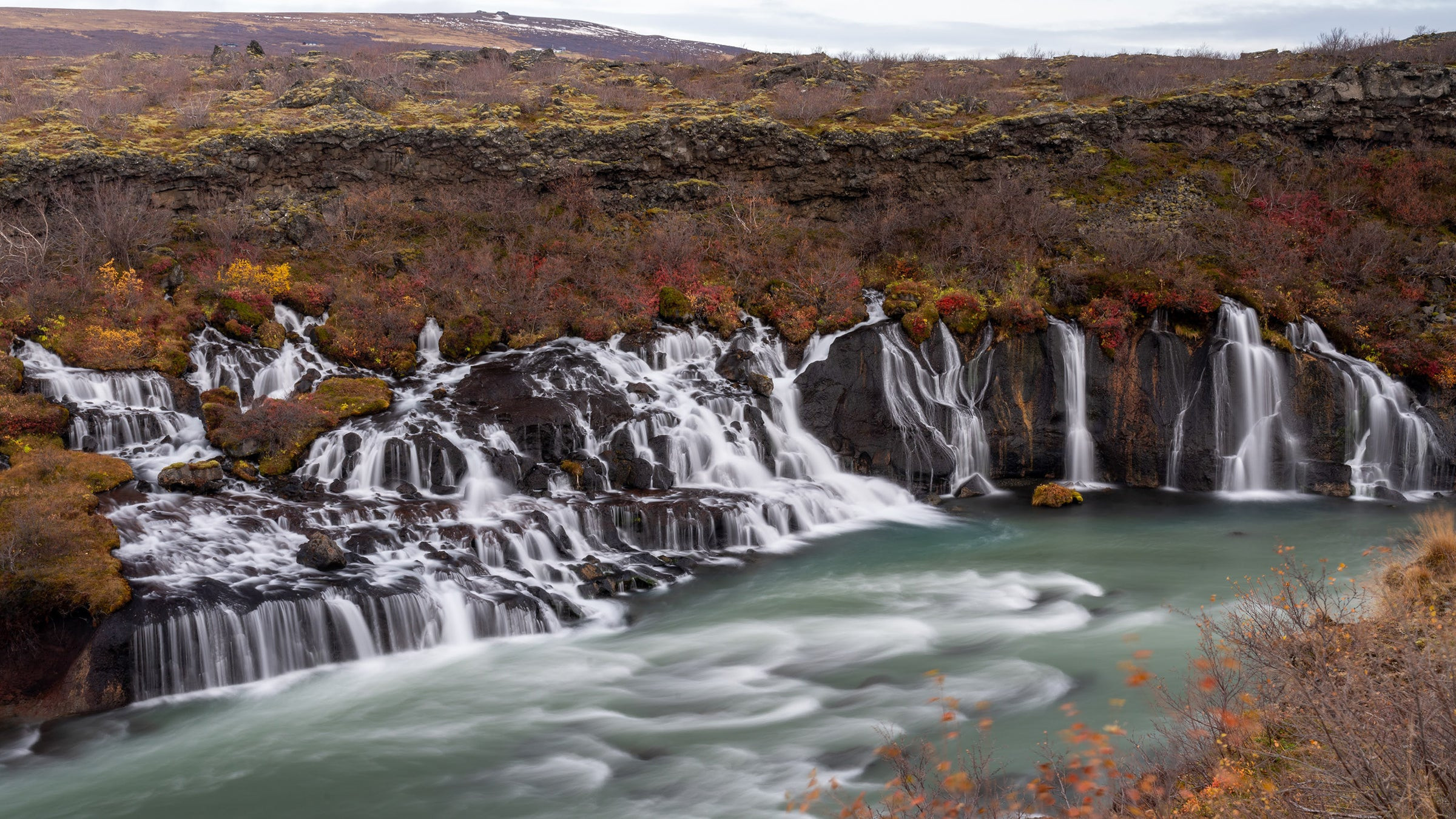 Just a handful of the dozens of waterfalls at Barnafoss
Just a handful of the dozens of waterfalls at Barnafoss
Barnafoss Waterfalls: A multitude of waterfalls cascading at Barnafoss, showcasing the raw power and beauty of Iceland’s water features.
Leaving Reykjavik, our first major stop was Barnafoss, about two hours northeast. This incredible site is a collection of countless waterfalls cascading in rapid succession. (FYI, “foss” means waterfall in Icelandic). If it’s windy, waterproof layers are essential, as the mist is intense. Barnafoss is perfect for practicing long-exposure photography (bring a tripod, ND filter, and lens wipes).
From Barnafoss, we drove back west for 20 minutes to the Krauma natural hot springs (entry around $50). While less “Instagrammable” than the Blue Lagoon (phones are discouraged at both), Krauma offers a relaxing array of geothermal pools and saunas, along with cold plunges and beautiful mountain views.
Next, we headed west to the Snæfellsnes Peninsula, a 55-mile stretch often called “Miniature Iceland” for its diverse landscapes. It boasts lava fields, waterfalls, black sand beaches, fjord views, hot springs, and the iconic Snaefellsjökull glacier volcano. I was particularly captivated by the lava fields, covered in vibrant green moss over endless black boulders.
We spent the night at Fosshotel Hellnar, a modest but clean hotel with stunning ocean views (off-season rates from $125 USD per night).
Day 2: Coastal Hikes and Dramatic Landscapes
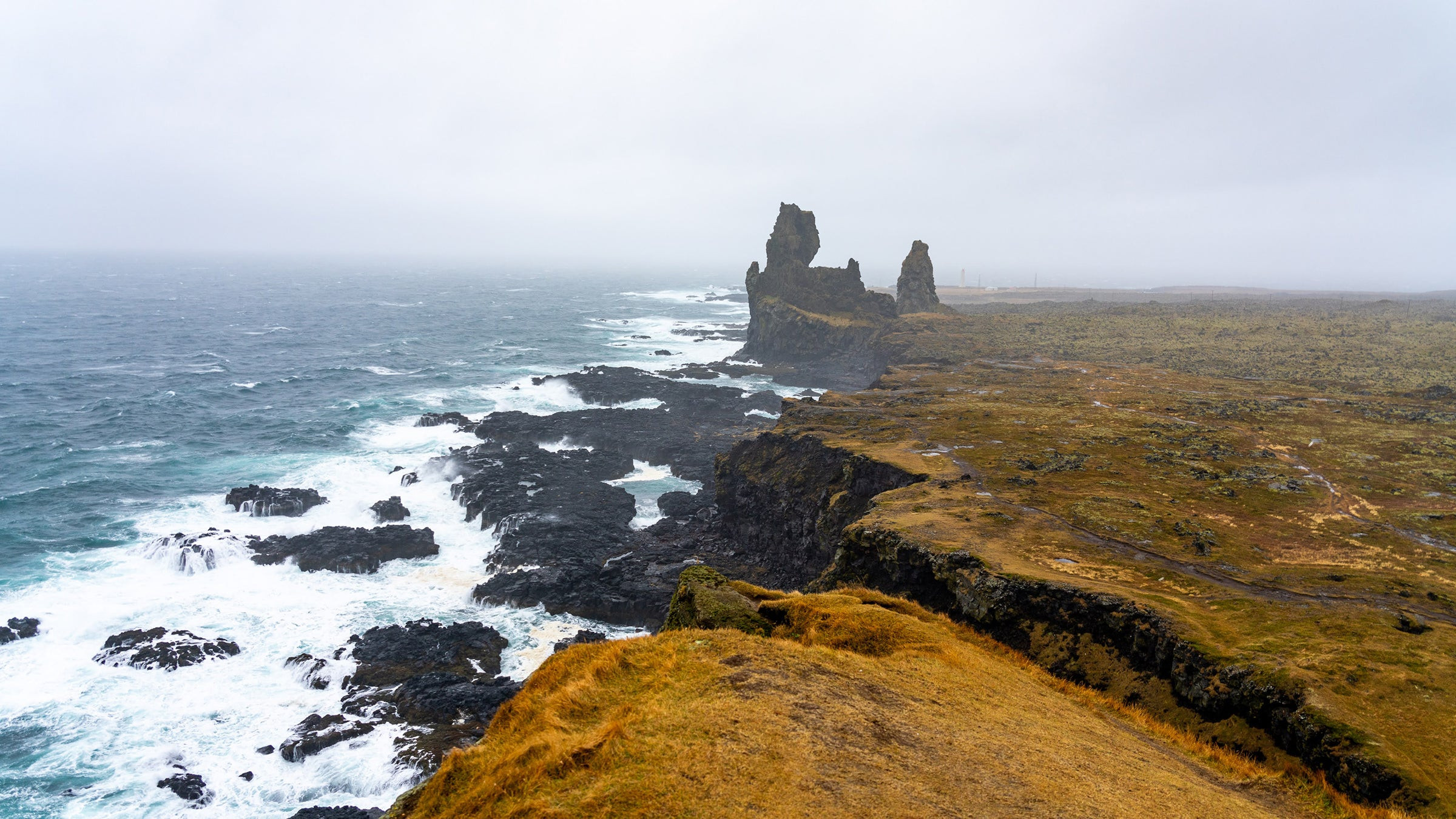 Swimming absolutely not recommended
Swimming absolutely not recommended
Dangerous Icelandic Coastline: A sign warning against swimming on Iceland’s rugged coast, emphasizing the power of the ocean.
We explored the westernmost tip of the Snæfellsnes Peninsula, stopping at viewpoints around Londrangar. Here, you can witness some of the most dramatic coastlines imaginable, with massive waves crashing against jagged volcanic rock formations.
We then ventured to Djúpalónssandur Beach and Djúpalón Lagoon, hiking along a shore covered in smooth, black pebbles and a lagoon that feels almost prehistoric. The entire area evokes a “Land Before Time” atmosphere.
Driving east along the peninsula’s northern side, we stopped at Bæjarfoss waterfall near Ólafsvík. My friend Pétur barely glanced at it – with approximately 10,000 waterfalls in Iceland, many breathtaking, this one was less exciting by local standards!
We also visited Súgandisey Island Lighthouse, greeted by a rainbow and strong winds. We stayed at Hotel Varmaland in Borgarnes (from $250), where I enjoyed a delicious lamb steak for dinner.
Day 3: Off-the-Beaten-Path Waterfalls and Geothermal Baths
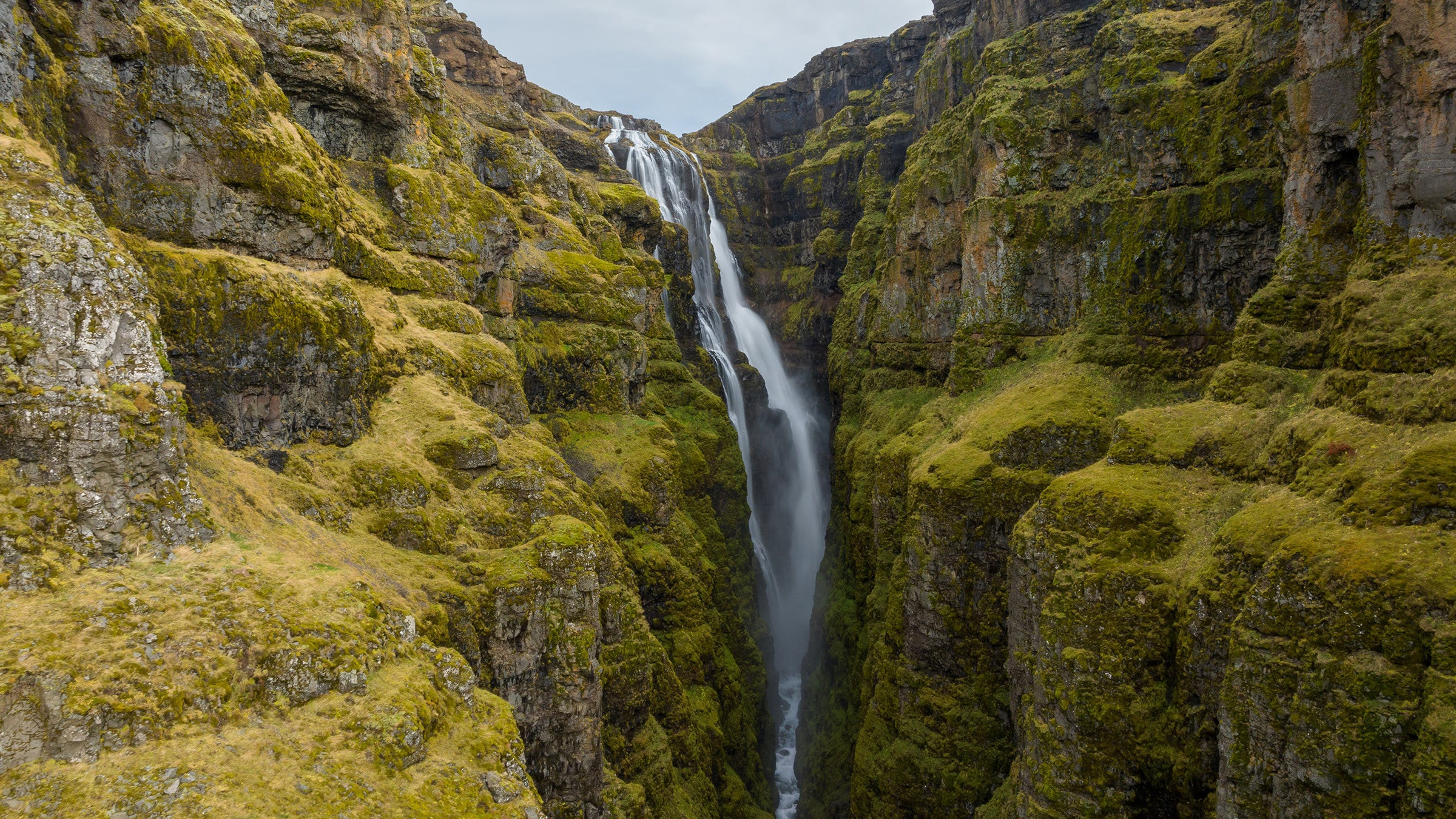 The magnificent Glymur Falls
The magnificent Glymur Falls
Majestic Glymur Falls: The towering Glymur Falls cascading down a cliffside, Iceland’s second-highest waterfall and a rewarding hike.
Day three was dedicated to chasing more waterfalls. First, we visited the small, secluded Fitjarfoss waterfall. We were the only visitors, enjoying its peaceful beauty. This was just a prelude to the challenging four-mile hike to Glymur Falls, Iceland’s second-highest waterfall at a staggering 650 feet. The hike is steep and slippery, involving river crossings and scrambling with significant exposure – hundreds of feet down to the river below. It’s not for the faint of heart but incredibly scenic.
Unfortunately, the river crossing was impassable during our visit, so we hiked as far as we could on one side. Luckily, Pétur’s drone captured stunning aerial views. Even without reaching the very top, the hike was well worth it.
We then relaxed at Laugarvatn Fontana Geothermal Baths (entry around $35 per adult), a beautiful complex of outdoor hot springs on Laugarvatn Lake. We alternated between hot soaks, saunas, and icy lake plunges – perfect for soothing tired muscles.
Day 4: Golden Circle Highlights
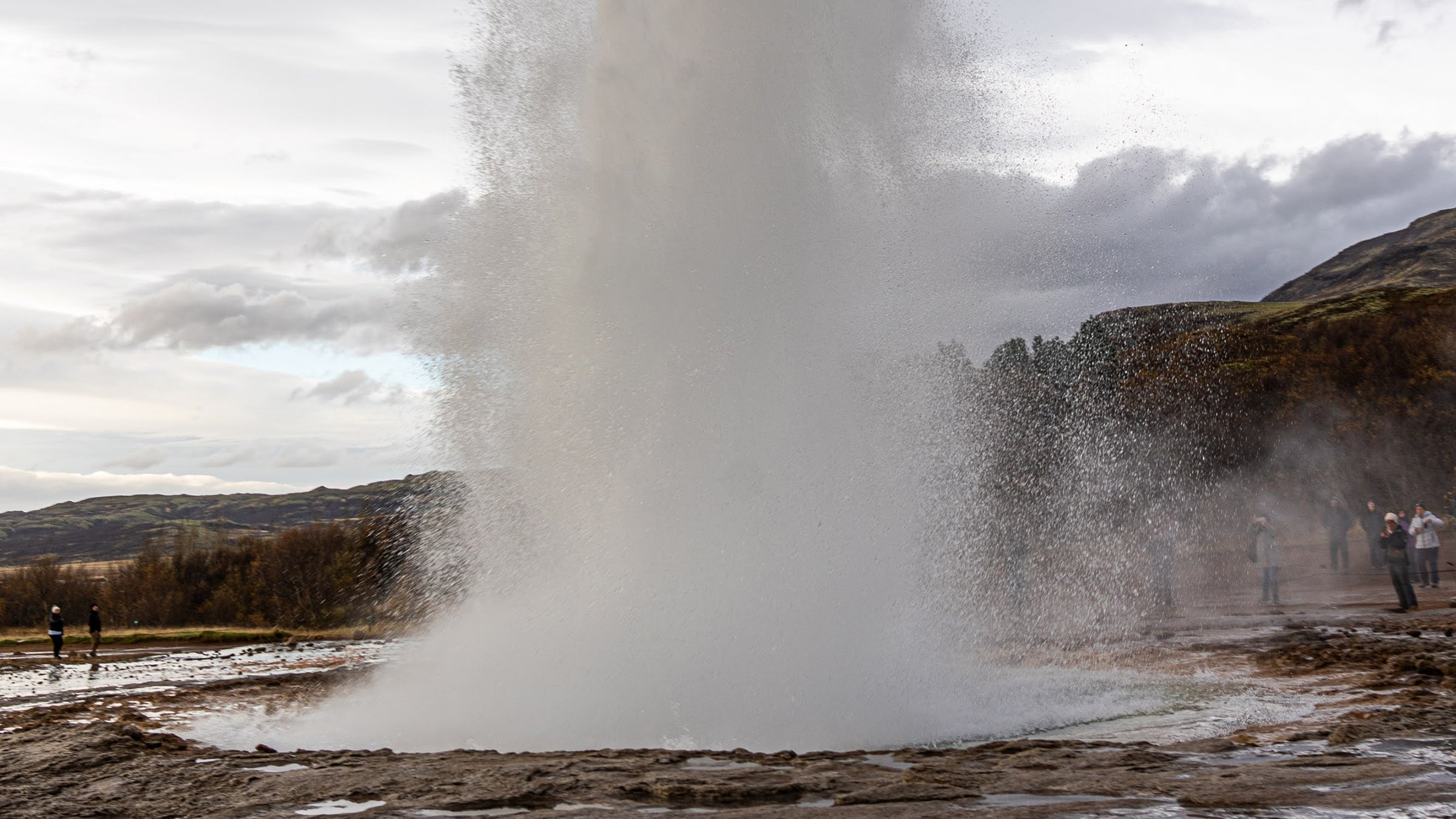 Strokkur Geyser doing its thing
Strokkur Geyser doing its thing
Strokkur Geyser Eruption: The Strokkur geyser erupting powerfully, shooting a column of hot water high into the Icelandic sky.
Our plan for day four was to take a ferry to the Westman Islands, but nature intervened. 60 mph winds and 18-foot sea swells cancelled ferry services for days. This is where shoulder-season flexibility shines. We cancelled our ferry and hotel reservations and, with ample vacancies everywhere, headed inland, away from the coast.
We anticipated fewer tourists due to the harsh weather and visited some popular Golden Circle sites. The Golden Circle is the most frequented day-trip route from Reykjavik, ideal if you have limited time and can’t drive the entire Ring Road.
Our Golden Circle exploration included Gullfoss, a massive, Niagara-esque waterfall. Despite the tourists and wind-driven mist, it’s an awe-inspiring sight.
Nearby is Geysir, the geyser that gave all others their name (“geysir” in Icelandic means “to gush”). Geysir itself rarely erupts now, but the adjacent Strokkur geyser erupts every 10 minutes, shooting water 60 to 120 feet into the air – quite a show! The area has numerous geothermal features, reminiscent of Yellowstone, with hiking trails offering various viewpoints.
Thingvellir National Park is also a must-visit. This historically significant site is where Iceland’s early clans gathered annually to make laws. It features a lake, waterfalls, and a museum with historical artifacts. Thingvellir is steeped in history and culturally significant to Icelanders, so be respectful when visiting.
Day 5: Surfing Iceland’s Waves
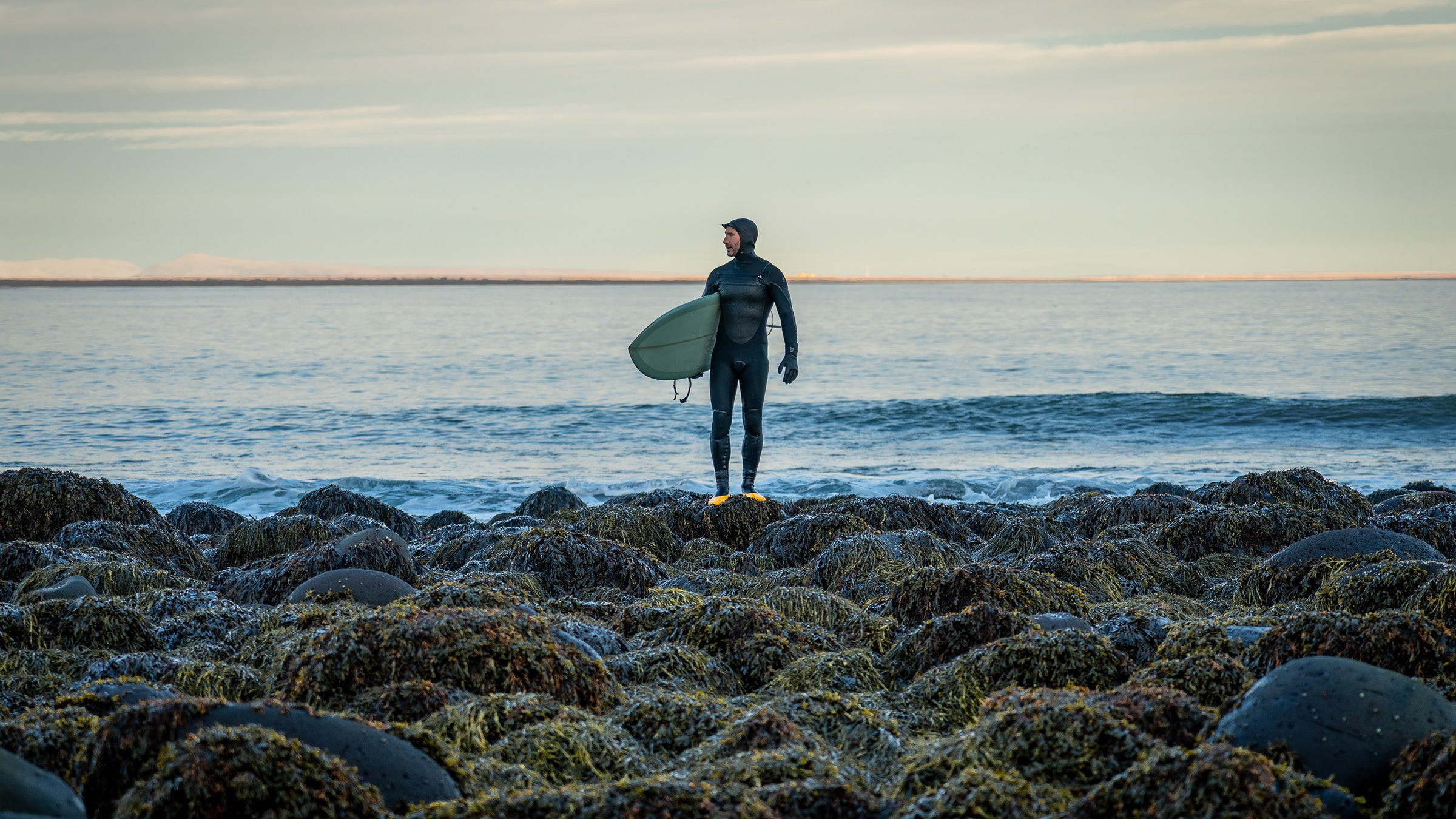 Fresh out of the perfect and endangered wave at Þorlákshöfn
Fresh out of the perfect and endangered wave at Þorlákshöfn
Icelandic Surfer at Þorlákshöfn: A surfer emerging from the cold waters of Þorlákshöfn in Iceland after riding a wave.
Surfing in Iceland was an unexpected highlight. I’d read about Þorlákshöfn, home to Iceland’s best and most consistent wave, which was under threat of being destroyed. The point break at Þorlákshöfn (near Thorli Beach) is a fantastic right-hander, reminiscent of Malibu but with far fewer surfers. However, the local council planned to fill it with boulders to expand the harbor, jeopardizing this surfing gem. Despite lacking environmental permits, they began dumping boulders, tragically cutting off part of the wave.
I contacted Steinarr Lár, a surfer leading the effort to save the wave, central to Iceland’s surf culture. He generously lent me gear. For those interested in Iceland surfing, Arctic Surfers organizes surf tours (from $350 per day) and provides equipment. They are also actively involved in the save-the-wave campaign.
After gearing up in the parking lot, a scramble over seaweed-covered boulders led to pure surfing bliss. The waves were perfect, and the friendly locals shared the lineup. Despite the cold water, the wetsuit kept me warm, and we all caught plenty of waves.
This incredible natural resource is being needlessly destroyed. Surf Þorlákshöfn while you can and support the effort to save it.
Days 6 & 7: Northern Lights and Luxurious Comfort
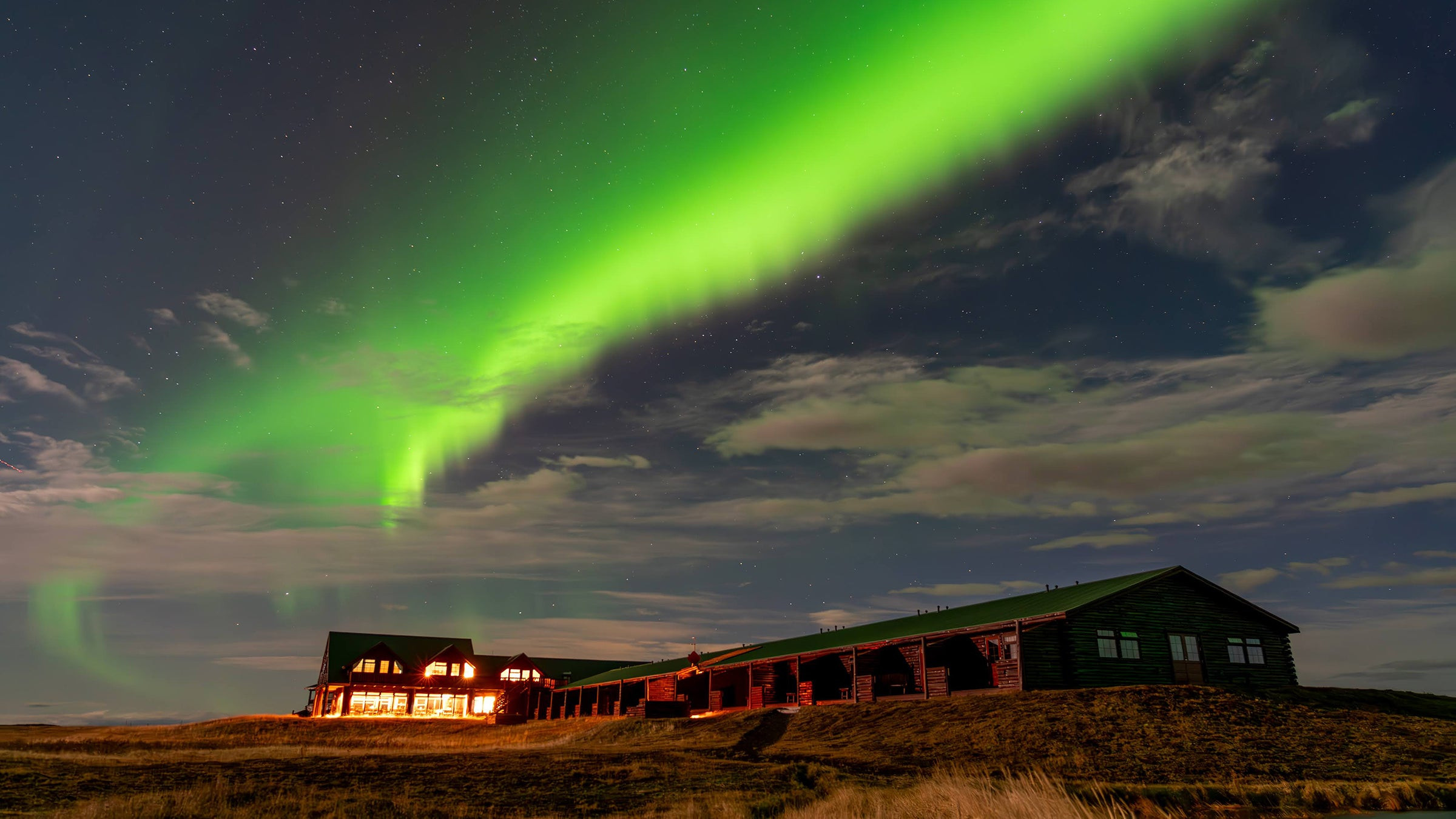 The Northern Lights popping off above the Hotel Rangá
The Northern Lights popping off above the Hotel Rangá
Aurora Borealis at Hotel Rangá: The Northern Lights dancing across the sky above Hotel Rangá in Iceland, a prime location for aurora viewing.
After days of adventure, I opted for some luxury at Hotel Rangá (pronounced ron-cow, from $340 per night in shoulder season). My friend Pétur, who works for a tourism company, recommends Hotel Rangá for Northern Lights viewing due to its isolated location and 360-degree views. It also has an observatory and a Northern Lights wake-up call service.
Hotel Rangá was the nicest accommodation of my trip and a perfect base for exploring Iceland’s south coast. Icelandic “upscale” is more understated than in the US, with a rustic, minimalist charm. Hotel Rangá’s restaurant was exceptional, with delicious lamb, fish, and reindeer carpaccio. They also offer a unique candlelit dinner in an ancient grass-roofed cave.
Despite no aurora forecast, we saw the Northern Lights on two nights! Around 11 PM, my phone rang – the lights were visible. I quickly dressed in layers and rushed outside. The sky was ablaze with waving green curtains. Reflections in the river and pond behind the hotel enhanced the spectacle. Seeing the aurora is an unparalleled life experience.
Bonus: Backcountry Iceland Adventures
 First light from my back porch at the Hotel Rangá before the day’s adventures
First light from my back porch at the Hotel Rangá before the day’s adventures
Sunrise View from Hotel Rangá: The author’s view of the Icelandic sunrise from Hotel Rangá, setting the stage for a day of adventure.
For the final days, I wanted to explore areas inaccessible to my friend’s AWD hatchback. I joined Southcoast Adventure for three off-road expeditions. I also went Icelandic horse riding.
Buggy Tour into the Highlands
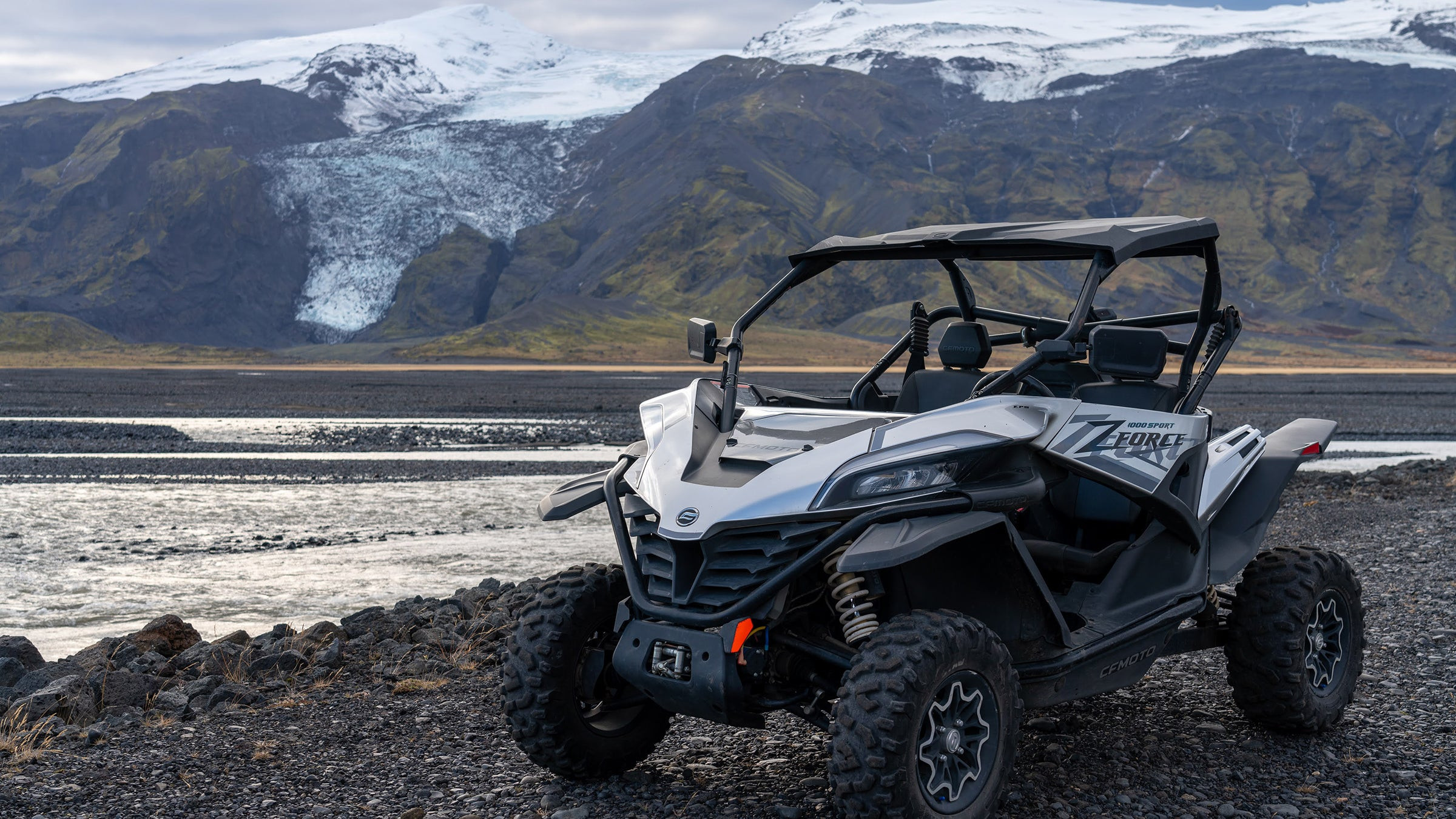 #buggylife (Yes, it’s a real thing and I’m officially a believer.)
#buggylife (Yes, it’s a real thing and I’m officially a believer.)
Iceland Buggy Adventure: Exploring Iceland’s rugged terrain in a 4×4 buggy, an exhilarating way to access remote areas.
Buggy tours are an incredible way to reach remote areas. These two-seat 4×4 ATVs with roll cages took us to Emstrur on a full-day adventure across dirt roads and streams. We saw waterfalls, glaciers, and stunning rock formations, encountering almost no other people. (Full-day tours from $660, shorter options available).
Katla Ice Cave Exploration
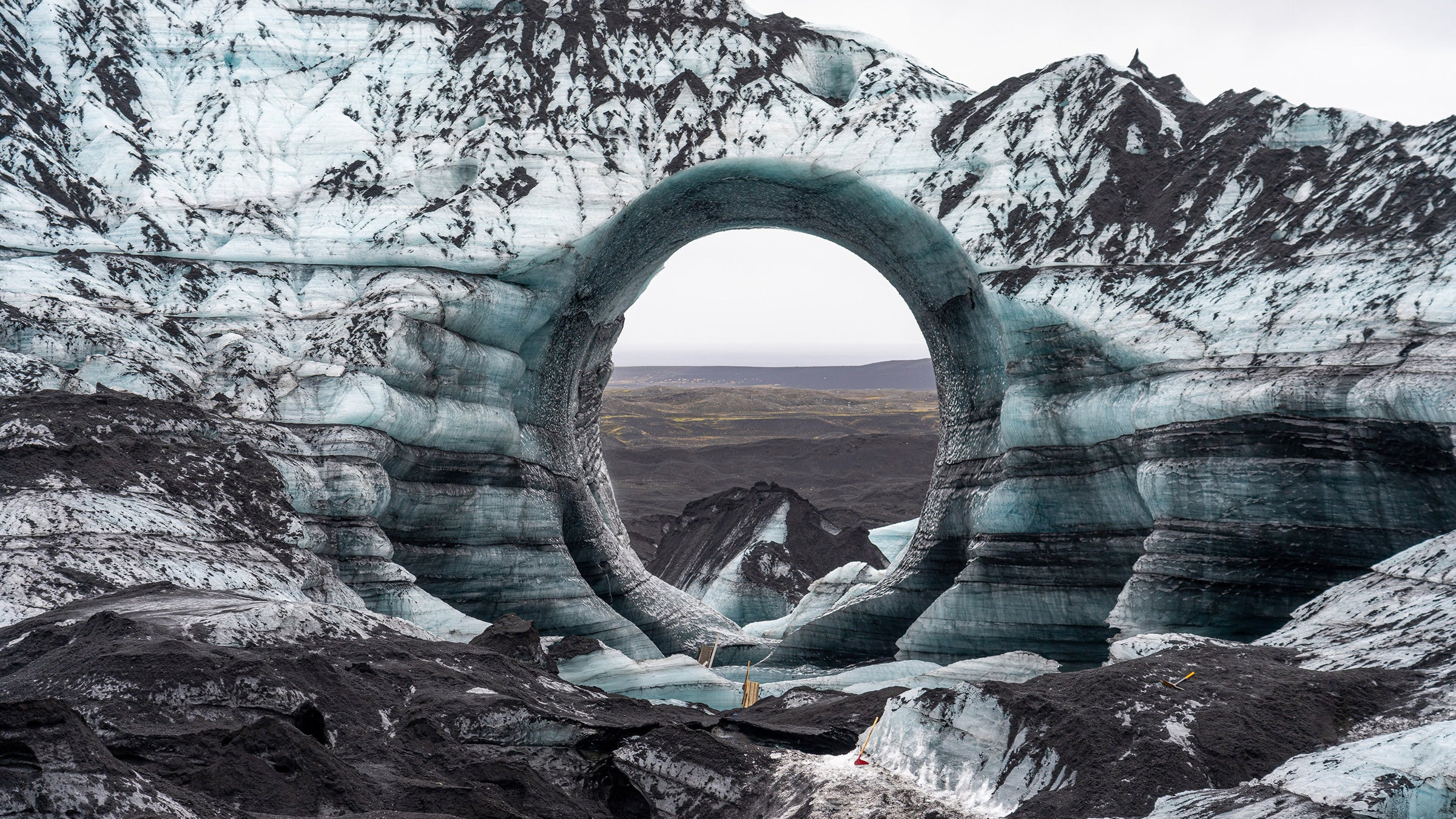 The largest of the Katla Ice Caves
The largest of the Katla Ice Caves
Katla Ice Cave Interior: Inside the mesmerizing blue ice caves of Katla volcano in Iceland, revealing the beauty of glacial ice formations.
Exploring the Katla Ice Caves was my favorite expedition (from $205 per person). These ever-changing ice caves at Myrdalsjokull glacier feature a massive ice arch and otherworldly tunnels of blue ice with streams and waterfalls. We even did some ice climbing (crampons provided, sturdy boots needed). On the way back, we visited Gljufrabui waterfall (hidden in a slot canyon) and Seljalandsfoss (walkable behind the falls).
Landmannalaugar Super Jeep Tour
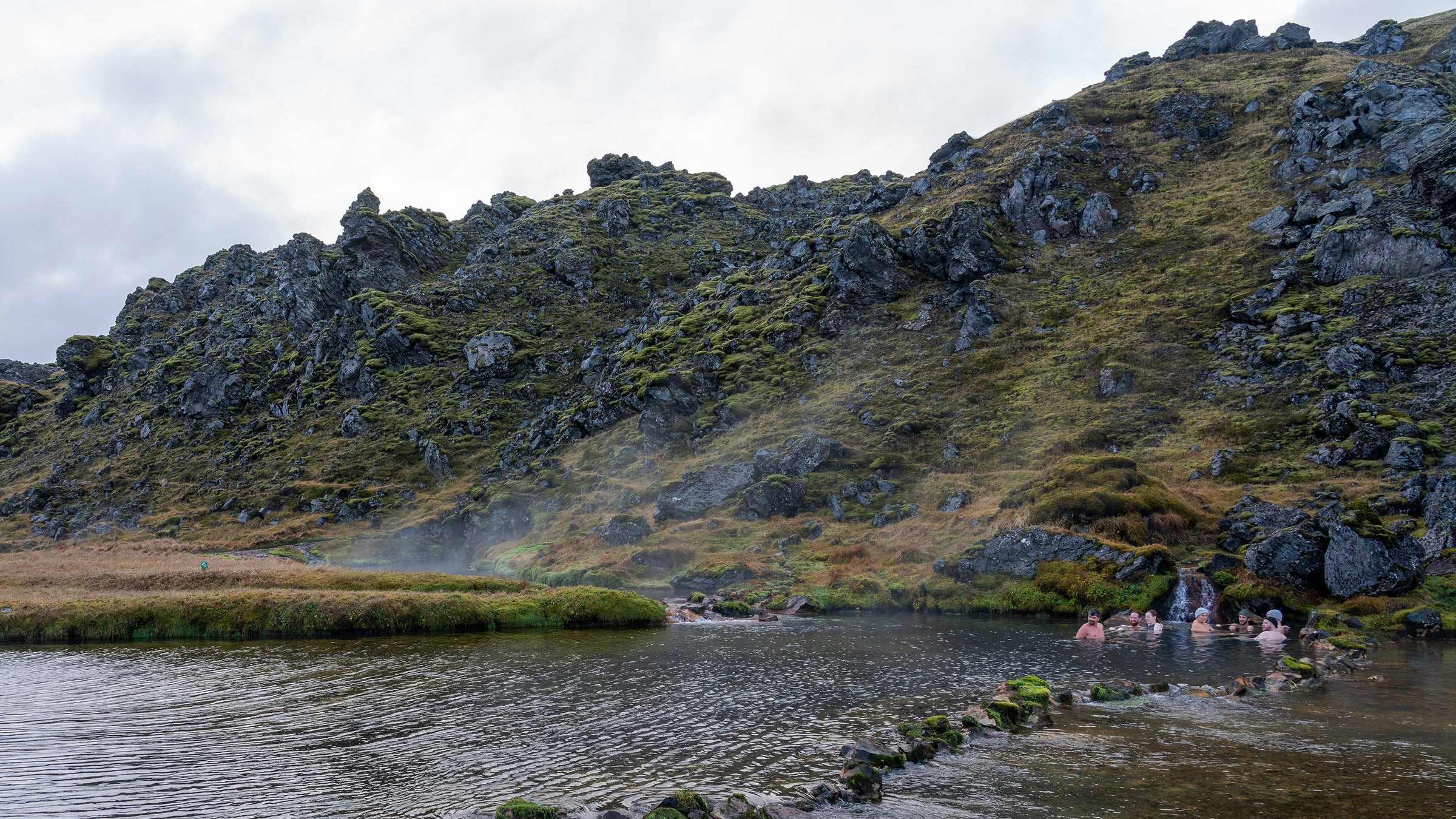 In Iceland, it’s always hotspring season. We took major advantage of that.
In Iceland, it’s always hotspring season. We took major advantage of that.
Highland Hot Springs in Iceland: Enjoying a relaxing soak in a natural hot spring in Iceland’s highlands, surrounded by stunning scenery.
The final day was spent in a “Super Jeep” (kitted-out 4WD Mercedes Sprinter van, from $300) exploring Landmannalaugar in the highlands. We traversed glacial paths and extinct craters, saw countless waterfalls, and relaxed in a stunning natural hot spring in Fjallabak Nature Reserve – the perfect end to the trip.
Icelandic Horseback Riding
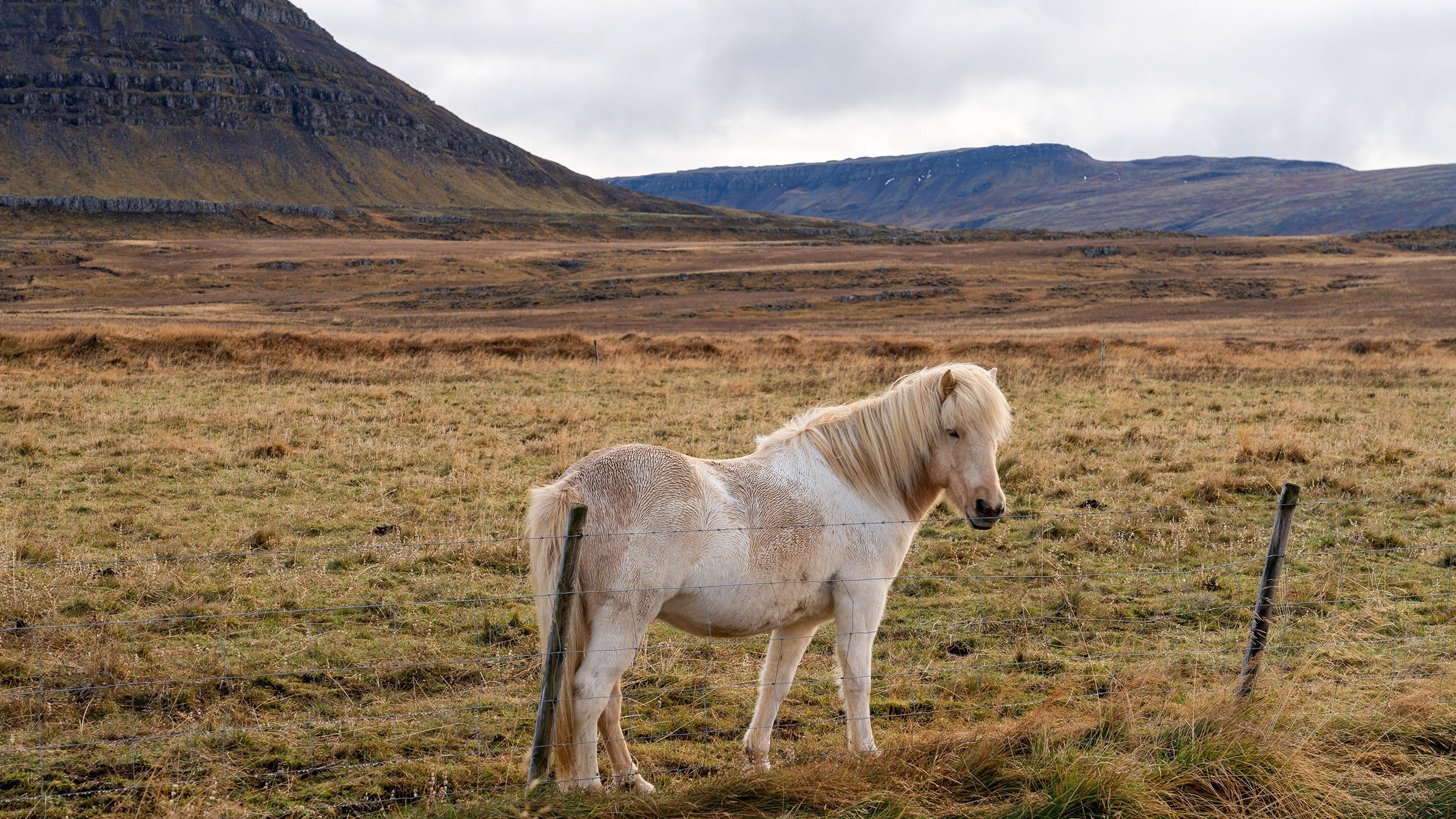 Icelandic horses really are that cool.
Icelandic horses really are that cool.
Icelandic Horses: A group of Icelandic horses in a field, showcasing their unique breed and sturdy build.
For relaxation, consider Icelandic horseback riding at Skeiðvellir Horse Farm (rides from $85/person). Icelandic horses, isolated for 1000+ years, are unique, with stout bodies, flowing manes, and special gaits. Riding them through Iceland’s grasslands is a wonderful experience.
Heliskiing in Iceland: A Thrilling Winter Adventure
 The stuff of powder-explorer dreams…
The stuff of powder-explorer dreams…
Iceland Heliskiing: Ski tracks in pristine powder snow in Iceland, with a helicopter in the distance, representing the ultimate ski adventure.
For extreme adventurers, consider heliskiing or snowboarding from mountain peaks to the Arctic Ocean with Viking Heliskiing (boutique operation in northern Iceland). Packages (from $7,200 per person for 3 days) include meals, gear, and luxury accommodation at Sigló Hotel. Terrain is steep and smooth, holding powder well. Runs can end right on the beach. Season is mid-March to mid-June.
Final Thoughts: Off-Season Iceland is My New Love
Iceland completely captivated me, and I now prefer shoulder-season travel there. Yes, the weather can be challenging, and some roads may be closed, but the benefits of fewer crowds and cost savings outweigh the drawbacks. Plus, the chance to see the Northern Lights is a major draw. So, pack layers, plan ahead, and embrace flexibility. If things don’t go exactly as planned? Þetta reddast…
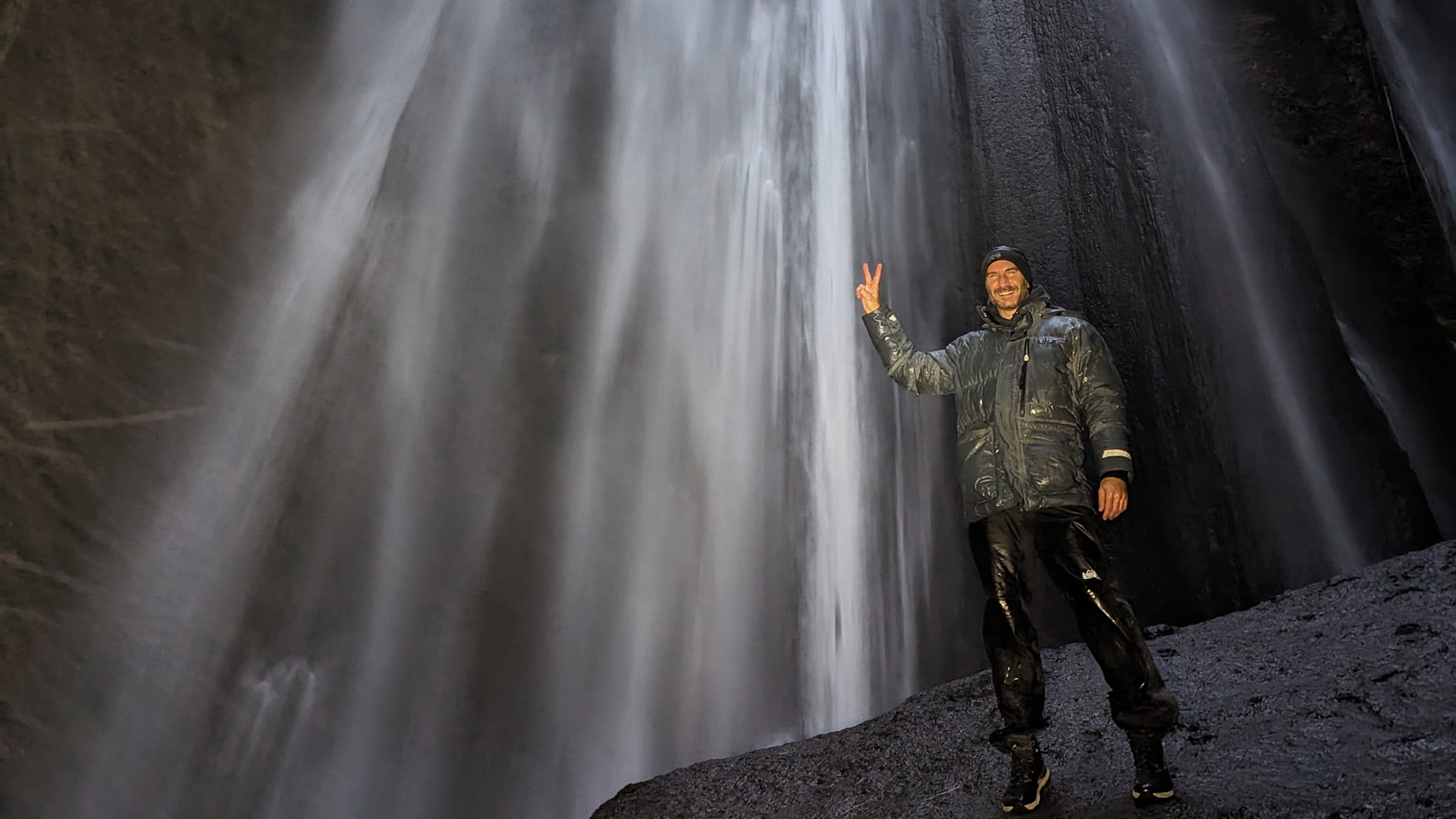 Your humble reporter, very wet. Worth it.
Your humble reporter, very wet. Worth it.
The Author in Iceland’s Elements: The author, soaked but smiling, illustrating the adventurous spirit of Iceland travel, even in challenging weather.
By Brent Rose, adventure and gear writer for Outside.

